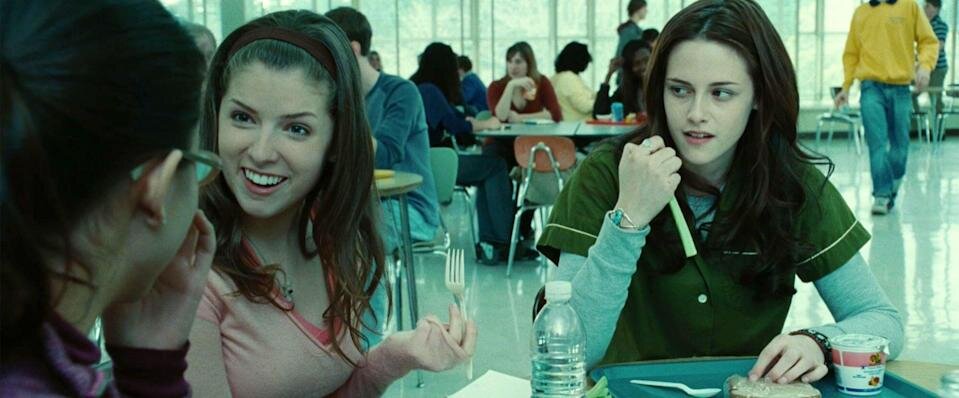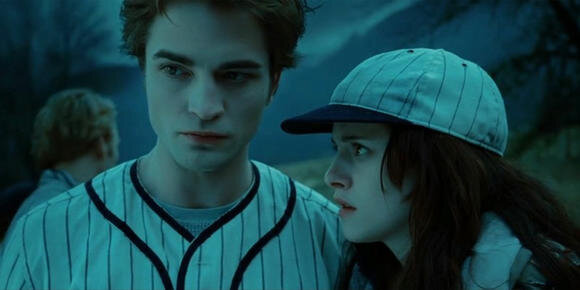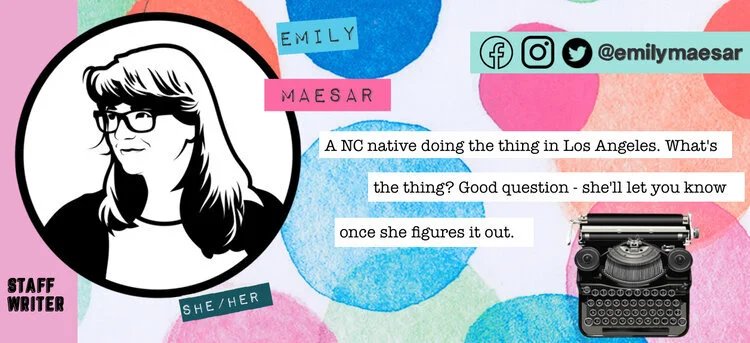You Can't Sit With Us: Justice For Teen Girls Who Read
by Emily Maesar, Staff Writer
About three things I was absolutely positive. First, Twilight is the most successful teen franchise of all time. Second, Lara Condor should have gotten the treatment that Noah Centineo got. And third, like most franchises aimed at women and girls… a woman only gets to direct the first film.
And just like that, I’m back to talk about book to film adaptations! Partially because I love them, even when they’re bad, but mostly because as far as profitable IP is concerned, there’s nothing better for a studio. Especially when trying to figure out what the teen market wants to watch, considering the books already have a built-in fan base. Ergo, book to film adaptation get made a lot.
First, and foremost, I wanted to use this particular column to talk about movies that were adapted from material also made for teens. Last time, I talked about adaptations of classic literature, which was super fun but has a very different vibe than the films I’m talking about this month. Second, though, I wanted to write about two films that I think really changed the landscape of teen films… a full decade apart. Which, all things considered, is a very odd thing to realize and come to terms with as someone who was very much a teen during the first of the films, and simply not during the second.
So, the film I was actually a teen for? That’d be Twilight, of course! Could I really talk about young adult literature being adapted into teen films without talking about the sparkly vampires and the not-quite werewolves? (They’re actually shapeshifters, which the films acknowledged but is kinda glossed over by basically everybody. Forever. Which I find fascinating.) The answer is certainly not. Bella Swan moves to Forks, Washington and falls madly in love with a 104-year-old vampire… and the world falls in love with them.
To really understand how the Twilight films changed teen films at large, we first have to look at how Stephenie Meyer helped finalize the ushering in of “Young Adult” as a demographic in publishing. So, for most of the history of publishing, the demographic divide was always kids vs. adults. Genre divides got more granular, obviously, but anything written for people under the age of 18 was generally just considered “children’s literature” or “kidlit.” Even the Harry Potter series, which got considerably more grown up as its audience grew, is still considered “middle grade.”
There is no doubt in my mind that Harry Potter was a major turning point, but in 2005 when Little Brown published Stephenie Meyer’s first book, Twilight, everything took a steep turn. You don’t have to be the first to make a change as big as creating a whole new demographic (one that’s still alive and well today), or to set off a genre boom (paranormal romance in YA really took off after 2005 for a surprising long period of time)... you just have to be the loudest.
And boy was Twilight loud. Well, its fans were. I should know–I was pretty loud at fourteen. As the books became an “International Phenomenon” that altered publishing in a way that remains deeply profound (and that I don’t necessarily have time to play out in this column about teen films), the film industry did what it does best: it adapted.
Because Twilight was big. Absolutely huge! And as the last book in the original series, Breaking Dawn, was being published, the first of the films was being adapted for the very large and already built-in audience of teenage girls and their mothers. And I don’t know if you know this (it’s totally fine if you don’t) but moms fucking love paranormal romance. Particularly vampires. We have True Blood for a reason, after all, and my mom was no exception. As I’ve talked about before, my mom was the one who pulled me into vampires because of the Buffy the Vampire Slayer TV series, but this was a franchise where I got to return the favor.
In 2008, the first Twilight film was released. And, uh… it was it’s own “International Phenomenon,” as a separate (but obviously related) piece of media. It grossed over $400 million worldwide on a budget of less than $40 million. And I would make the argument that other than just being something that was always going to be popular, part of what really made the film (and the subsequent films) hit as hard as they did was that it was a way for the fans to relive through the parts of the story that they loved. Like, Breaking Dawn did very well in sales, but it’s not overly loved compared to the other books. So, by having the films start the year the least loved book came out? Well, that’s an easy way to keep the momentum for the story of Bella and Edward alive.
And alive their love certainly stayed (even now, which is wild). With Meyer finally writing and releasing Midnight Sun, which was Twilight from Edward’s perspective, and all five films being added to Netflix, Twilight is firmly back in the cultural zeitgeist. It also helps that we, as a culture, are reassessing our relationships to a lot of media beloved by women and girls from the middle and late aughts and trying to come to terms with… all of that.
We’ll talk more about all of that in a bit, but first let’s chat about To All The Boys I’ve Loved Before, the movie I was very much an adult for! Based on Jenny Han’s best-selling YA novel by the same name, To All The Boys is a teenage rom-com about a girl whose love letters from throughout her young life get sent to every boy she ever addressed one to. She ends up faking dating one of the guys, which turns into an actual romance (of course).
So, here’s a little perspective on Netflix’s catalogue up to the time when this film was released. In 2017, Netflix released a single film that is categorized as a “romantic comedy.” 2018, however, can be considered the year that they decided to revive the genre as a whole. They released about 13 romantic comedies in a 10 month span, after all. It’s often said (and it’s certainly something I agree with, just looking at the data), that with the rise of high-budget action films, the smaller mid-tier films started dying. This was true of romantic comedies, comedies that didn’t have a big star as their lead (less actual comedians, more action stars flexing their comedy muscles), and small dramas. Horror still reigned supreme because it’s always been lower budget and you don’t need stars to sell it, but other genres like middle of the road science fiction and fantasy have gone the way of the dodo in the last twenty years.
So, when Netflix decided to essentially revive romantic comedies, it was a big deal. Particularly that they revived teen rom-coms. And, as Hollywood has known for a long time, the best way to do that is by adapting an already existing IP because it has a built-in audience. And what that means is that it isn’t as much of a risk. Which was the case with The Kissing Booth, a Netflix original that did amazingly well, and came out a few months before To All the Boys I’ve Loved Before premiered.
Now, the issue with To All the Boys being a Netflix film, compared to Twilight’s really wide release ten years before, is that… well? I can’t actually tell you how well the film did. It’s fair to say that it’s well received, since most reviews are positive, and that its watch numbers were high enough that both sequels were greenlit and made. Other than that, though? I can’t give you anything. Not really.
So, what Twilight represents, in the history of teen media, is the beginning of some biggest trends that ended up changing the book and film worlds. And what To All the Boys I’ve Loved Before represents is the true renaissance of the teen rom-com (and the wider trend of rom-coms in general).
But they are both casualties of sexism in the film industry. They are prime examples, especially in the teen genre, of women being entrusted to usher in a series made and marketed toward women and girls… only to be kicked off the franchise once the next film is made. Twilight is perhaps one of the highest profile examples of this trend, with Catherine Hardwicke being given a mini cupcake for all the opening weekend success and then being called too “difficult” to direct any of the other films in the franchise. Instead, men directed the other four films in the series.
And then there’s To All The Boys I’ve Loved Before. Susan Johnson only directed the first film in the trilogy, the reins of which were handed off to the cinematographer of the first film, Michael Fimognari. And these aren’t the only times that this exact event has happened. In the more adult world, you have the 50 Shades of Grey films and the After series. Both of which had their first films directed by women, Sam Taylor-Johnson and Jenny Gage respectively, only to have the subsequent films directed by men. Because women are allowed to usher in these franchises and bring them to prominence, but once they get too big? Well, it’s time for the men to step in, apparently. I will say, however, that it looks like After is having a woman take back the director’s chair for the third and fourth films. So, good for them! I’m not gonna watch any of those, but absolutely good for them!
However, the sexism also goes into the way we, as the audience, have treated the women at the center of these stories, as well. It should not surprise you how the general world at large treated Kristen Stewart during her involvement in the monster machine of the Twilight franchise. Especially compared to Robert Pattinson. No one can really say they were above it, since it was so instrumental to the attitudes of the late aughts, sadly. (I could write papers upon papers about the way women are treated in fandom during this time, both fictional and otherwise, by other women.) And while it’s good that no one has been horrible (at least in the same ways) to Lara Condor, she has been systematically overshadowed by Noah Centineo - who then was overexposed. Which… is neat. Yeah. It’s really cool. Totally great use of our time, culturally.
So, I really, really hope that Lara Condor gets the renaissance that she deserves. Like, rewatching the flick for this column reminded me how absolutely hysterical she is. Put her in comedies. I am begging you! I’m glad that we’ve circled around on Kristen Stewart (and even Robert Pattinson), who has become an indie darling and absolute queer icon.
With the popularity of Twilight refusing to quit, and the (re)rise of teen rom-coms, I think that both of these films (and all the women who made them possible), have some of the longest staying power in the teen film consciousness. Which is more than some of the films I’ve talked about over the last year can actually say!







